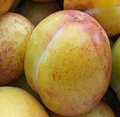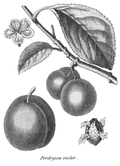| Common name | Image | Color | Additional information | Refs |
|---|
| Alderman | | Burgundy | Large yellow fleshed fruit. From Minnesota | [1] |
| Arandana | | | | |
| Amber Jewel | | Crimson Red | Skin with an orange or gold blush | [2] |
| Black Amber |  | Dark Crimson | | |
| Black Ice | | Dark Blue | Red flesh and tough skin, vigorous and hardy | [1] |
|
| Bullace |  | Blue | | |
| Casselman | | Red | Smooth-skinned and can be either fairly firm or slightly soft and are very sweet | [3] |
| Damson |  | Blue | | [4] |
| El Dorado | | Dark Purple | Has amber flesh and a sweet flavor even when firm | [3] |
| Greengage |  | Green | | [3] |
| Laetitia plum |  | Red | | [5] |
| LaCrescent | | Yellow | Yellow flesh, freestone | [1] |
| Lemon plum |  | Yellow | | |
| Mirabelle |  | Yellow | | [6] |
| Mount Royal | | Deep blue | Yellow-green flesh, hardiest of the European plums | [1] |
| Opal |  | Light red | Bred in Sweden and released in 1925. A cross between a plum and a gage. | |
| Perdrigon |  | | | |
| Pembina | | Red (with blue bloom) | Yellow flesh. From South Dakota | [1] |
| Pipestone | | Red | Very large fruit with yellow sweet juicy flesh, clingstone | [1] |
| Queen Garnet | | Dark red | Red flesh. Rich in anthocyanins. Originated in Australia | [7] |
| Reine-Claude |  | Yellow | | |
| Santa Rosa | | Red-violet | | |
| Superior | | Red | Large fruit with yellow sweet juicy flesh, clingstone | [1] |
| Toka | | Red | Yellow flesh, also known as the bubblegum plum. From South Dakota | [1] |
| Underwood | | Red | From Minnesota, medium yellow fleshed fruit | [1] |
| Victoria |  | Red | | |
| Waneta | | Red | Yellow flesh, prolific. From South Dakota | [1] |










